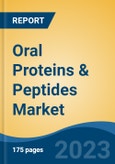Speak directly to the analyst to clarify any post sales queries you may have.
10% Free customizationThis report comes with 10% free customization, enabling you to add data that meets your specific business needs.
Key Market Drivers:
Increasing Prevalence of Chronic Diseases
The rising prevalence of chronic diseases is a key factor driving the growth of the oral proteins and peptides market. As the global population ages and lifestyles become more sedentary and unhealthy, the incidence of chronic diseases is increasing. This leads to a larger patient pool that could benefit from oral protein and peptide treatments. According to the World Health Organization, noncommunicable diseases (NCDs) were responsible for 43 million deaths, accounting for 75% of all global deaths unrelated to pandemics. Cardiovascular diseases were the leading cause with 19 million deaths, followed by cancers (10 million), chronic respiratory diseases (4 million), and diabetes (over 2 million). Notably, low- and middle-income countries accounted for 73% of these NCD-related deaths.Patients with chronic conditions are increasingly seeking convenient treatment options. Many require long-term or lifelong therapies, and traditional methods such as injections or infusions can be burdensome. Oral proteins and peptides provide a more patient-friendly alternative, as they can be taken in the form of a pill or liquid, eliminating the need for painful, frequent injections. Additionally, non-adherence to prescribed treatments is a significant challenge in managing chronic diseases. Oral formulations help address this issue by increasing patient compliance, as treatments that are easier to administer and less intrusive encourage better adherence and lead to improved health outcomes.
Key Market Challenges:
Stability and Bioavailability
A major challenge in the oral administration of proteins and peptides is their susceptibility to degradation in the harsh environment of the gastrointestinal tract. Ensuring their stability and maintaining adequate bioavailability remains a complex issue that requires advanced formulation technologies.Key Market Trends:
Advancements in Nanotechnology and Drug Delivery Systems
Nanotechnology is transforming drug delivery in the oral proteins and peptides market. Nanoparticles and nanocarriers are being developed to encapsulate and protect these sensitive molecules, enabling more precise delivery and enhanced bioavailability. These innovations are expected to expand the range of treatable diseases and improve therapeutic outcomes.Key Market Players:
- AbbVie Inc.
- Merck & Co., Inc.
- Pfizer Inc.
- Novo Nordisk A/S
- Hoffmann-La Roche Inc.
- Sanofi S.A.
- AstraZeneca PLC
- Bristol-Myers Squibb Co.
- Tarsa Therapeutics Inc.
- Novartis AG
Report Scope:
This report segments the Global Oral Proteins & Peptides Market into the following categories, with detailed insights into each:
By Drug Type:
- Calcitonin
- Insulin
- Linaclotide
- Octreotide
- Plecanatide
By Application:
- Bone Diseases
- Diabetes
- Gastric & Digestive Disorders
- Hormonal Disorders
By Region:
North America:
United States, Canada, MexicoEurope:
Germany, United Kingdom, France, Italy, SpainAsia-Pacific:
China, Japan, India, Australia, South KoreaSouth America:
Brazil, Argentina, ColombiaMiddle East & Africa:
South Africa, Saudi Arabia, UAE, KuwaitCompetitive Landscape and Company Profiles:
This section offers an in-depth analysis of the major players in the Global Oral Proteins & Peptides Market.Available Customizations:
TechSci Research provides customized reports tailored to specific market needs. The following customization options are available:
- Detailed analysis and profiling of up to five additional market players.
This product will be delivered within 1-3 business days.
Table of Contents
Companies Mentioned
- AbbVie Inc.
- Merck & Co Inc
- Pfizer Inc
- Novo Nordisk A/S
- Hoffmann-La Roche Inc
- Sanofi SA
- AstraZeneca PLC
- Bristol-Myers Squibb Co
- Tarsa Therapeutics Inc
- Novartis AG
Table Information
| Report Attribute | Details |
|---|---|
| No. of Pages | 180 |
| Published | March 2025 |
| Forecast Period | 2024 - 2030 |
| Estimated Market Value ( USD | $ 1.33 Billion |
| Forecasted Market Value ( USD | $ 2.26 Billion |
| Compound Annual Growth Rate | 9.4% |
| Regions Covered | Global |
| No. of Companies Mentioned | 10 |









